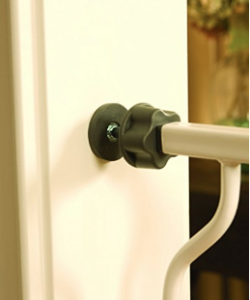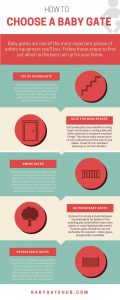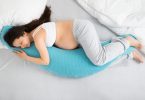I don’t know where I would have been without baby gates! A reliable, easy-to-use baby gate (or stair gate) is one of the most important investments you’ll make when it comes to keeping your baby out of harm’s way. Read on for the ultimate guide to choosing the right baby gate for every room in your house. If you prefer a visual guide head over to our infographic.
How to choose a baby gate
Finding and choosing the right baby gate is a confusing business! I literally didn’t know where start so I read every site I could find to work out what I needed. I bought three stair gates when my children were showing signs of getting active: one for the bottom of the stairs, one for the top and one in the entrance to my kitchen, that way all the major danger points were covered.
It’s best to start doing your research into baby gates and stair gates well before your little one is on the move, starting with an assessment of your home and your living habits. Every house is different and there’s a lot to consider before you splash the cash.
Swing gates
Retractable gates
Travel gates
Pressure fit gates
Hardware mounted gates
Main considerations when choosing a baby gate
Choosing the right baby gate for you will be down to where you are putting it, features, and your own personal preference in terms of materials and how it operates. As yourself a few questions from the get-go:
Where is the gate for?
If it’s for a doorway or hallway then you can choose either pressure or hardware mounted gates.
Any gate at the top of a staircase obviously needs to be completely secure and safe to avoid any nasty accidents. Generally speaking hardware mounted gates tend to be the safest and most robust gates for this area, but there is at least one pressure mounted gate recommended for top of stairs use if used with the supplied wall cups.
Width and location of your space
If your space is wider than 72 inches you will need either an extra-wide swing gate or step over gate (hardware mounted if protecting the top of your staircase). If you have a small or awkward space swing gates can get in the way. Retractable gates roll up like a blind into their housing, out of sight and out of harm’s way
Do you have a pet?
If you have pet that is too big to squeeze through the bars of a swing gate and too small/unwilling to jump over it then it’s worth considering a baby gate with a pet door. Pet doors are only available in swing gates.
Portability
Pressure fit gates and travel barriers are both great if you want to be able to move your gate from room to room, or even house to house. There are no screws so no unsightly holes to worry about – it couldn’t be easier. But, if you need or prefer hardware mounted gates and would like something portable some retractable gates come with two sets of hardware mounts and are portable – just fix the mounts wherever you need them, slide the gate out of the housing and clip it into the spare mounts (super easy to do).
Do you need a gate for outdoor use?
Not all gates are suitable for use outside – check the manufacturer’s blurb. Metal gates that aren’t made for the elements can rust or fade.
Your child’s height
Kids come in all shapes and sizes and baby gates are no different. Most gates stand at around the 30 inch height but there are plenty to accommodate taller children.
Is it easy to use?
It goes without saying that baby gates should be impossible for a small child to open – but you should be able to open it with ease, and importantly with one hand! Do you have space to open a gate into your room or would you prefer something that tucks away neatly?
How it looks
Safety and ease of use are obviously the most important things to consider but since you have to look at it all day for the next few years it helps if you like the way it looks too!
Baby and stair gates come in a range of colours and materials depending on your needs and taste: metal, wood, mesh, black, white pink. You won’t be stuck for choice.
What kind of baby gate?
Now you have an idea about what you need let’s look a bit closer at the types of gates available.
Swing, or retractable?
Swing gates can either be hardware mounted or pressure fit. If you’re using yours on the stairs hardware mounted is generally the best choice.
Swing gates
Side opening gates are available in wood or metal and are arguably the most popular kind of baby gate. But, they can be a bit of a pain when they’re open, particularly in small or awkward spaces – so it pays to make sure you can fully open the gate without obstructing anything.
Check the width of your doors before you buy – you might need to buy an extension kit to bridge the gap (or rethink your whole set up).
I personally used a combination of retractable and side-opening gates – side opening for a larger space between the kitchen and main living area and retractable gates in my boys’ bedroom and at the top of the stairs where space is more limited.
Swing gates are available with hardware mounts (which makes them safe for the top of the stairs) or pressure fit, for just about anywhere else. The main advantage of pressure gates is that they won’t damage your walls or woodwork.
Retractable gates
Retractable gates work in a similar way to a roller blind: the ‘blind’ part sits in a hardware mounted frame along a vertical door frame and is unfurled when needed. Because they’re hardware mounted they’re a great choice for the top of the stairs.
These gates are super compact and great if you have a small space, don’t want the hassle of a gate that has to be negotiated every time you go into a room or if you prefer a baby gate that blends into the door frame when you’re not using it.
On the whole retractable gates are easier to operate than swing gates. Most gates open with a push and a rotate action which is so easy, even with a baby in your arms. I love that they’re unobtrusive, and seem to be ahead of the game in terms of style too. We haven’t needed baby gates for my children for a few years now but I’ve kept my retractable gates up for visiting friends’ babies and to keep my kids from wandering downstairs at bedtime – I barely know they’re there.
Retractable gates will make a bigger dent in your wallet than most swing gates but I think they’re worth it!
Travel Gates
Travelling with babies can be a stressful business, especially if you’re staying in a house or apartment which may or may not be set up for little ones. Safety barriers (the omission of the word ‘stair’ is no mistake) offer a solution to roaming movers by providing a temporary barrier between rooms. As you would expect they’re light, collapse for ease of carrying around, are pressure mounted and adjustable to accommodate a range of doorways. The barrier can’t be opened as such so it’s a case of climbing over or releasing the pressure lever to remove it completely.
It’s worth noting that travel barriers aren’t as robust as the more permanent options and shouldn’t be used as a long term solution and never around stairs.
Pressure Fit Gates
These gates are held in place by pressure pads at each of the four corners. They’re very easy to set up and because there are no screws involved won’t leave holes behind and can easily be moved around the house (or taken on holiday if weight and size aren’t an issue).

Pressure mounted gates have a horizontal bar along the bottom with pressure points either side that make the gate secure but also create is a trip hazard. For that reason it’s not advisable to use pressure fit gates at the top of stairs. I had a pressure fit gate between my kitchen and living area and we all got used to stepping over it. For me it was a much easier option in terms of setting up and we could throw it in the car and take it to the grandparents’ really easily.
Gates are available in metal or wood and can be extended if you have a wide door frame (extension kits need to be bought separately).
Pros
Easy to install and won’t leave holes in your door frame
More portable than screw fit gates
Cons
Potential trip hazard
Can’t be used on stairs (unless fixed with wall cups)
Hardware mounted gates (for top of stairs)
Hardware mounted gates, which, as the name suggests, are mounted with hardware and screwed to the door frame are the sturdiest of the lot which makes them perfect as a stair gate.
It does take a bit of patience and careful measuring to fit a baby stair gate (and careful measuring to work out whether you need extensions), but you’re rewarded with the peace of mind of a robust gate and no trip bar to worry about.
Because they’re screwed into the frame this is a less portable solution but a great option if you’re looking for a super strong gate that will withstand everything a busy family can throw at it.
Some swing gates do have quick-release brackets so that you can move gates from room to room (extra mounting hardware is required which some manufacturers will supply).
Pros
Very robust
No trip hazard so suitable for the top of the stairs
Cons
Slightly harder to fit and will leave holes behind
We hope our Baby Gate Buyer’s Guide has helped you figure out which gate(s) you need. Head over to our baby gate reviews for the best rated baby and stair gates, for each type of gate.
Click to expand.








